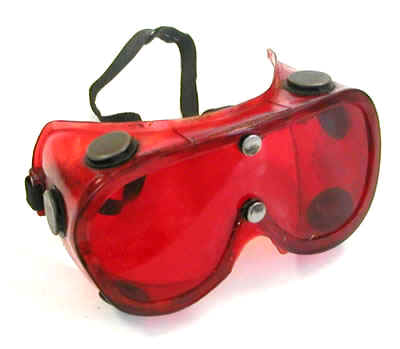Red Goggles (ca. 1940s)

These red goggles were produced by the Picker X-ray Corporation, probably in the 1940s. They would have been worn by a physician prior to a fluoroscopic procedure as a way to dark adapt the eyes while still being able to see well enough to function. The alternative, waiting twenty minutes or so in a completely dark room, was pretty darn inconvenient. The image intensifiers that came along in the 1950s increased the brightness of the fluoroscopic image to the point that the procedure no longer had to be performed in complete darkness. As a result, dark adaptation became unnecessary.
Red adaptation goggles were invented by Wihlem Trendleenburg in 1916 who noted that adapting the eyes in the dark might end up "with the result that one makes one's stay in the dark too brief and is then tempted, by overloading the tube, to obtain brightness objectively, which one should have obtained subjectively by an increased visual sensitivity. As opposed to this procedure, it would be of great value to have an effective method of preparing the eyes for fluoroscopy, which would not hinder the examiner in the performance of other work during the period of preparation of the patient for the examination."
During fluoroscopy, the physician relies on the use of the retinal rods of the eye. Since the rods are almost totally insensitive to the longer wavelengths of light, the rods can be sensitized in red light. The cones of the eye, not used for fluoroscopic work, have no problem responding to red light.
The circular black "disks" around the sides of the goggles are air vents.
Reference
Eisenberg, R.L. Radiology, An Illustrated History. Mosby Year Book. 1992.
